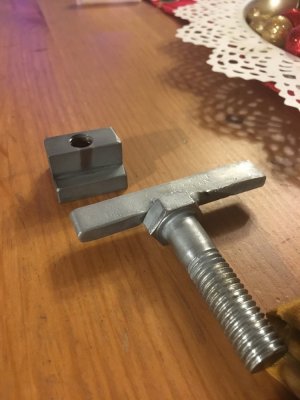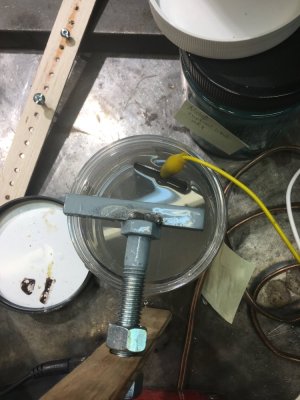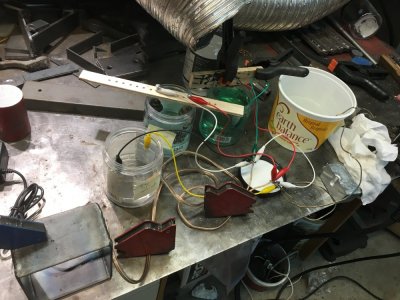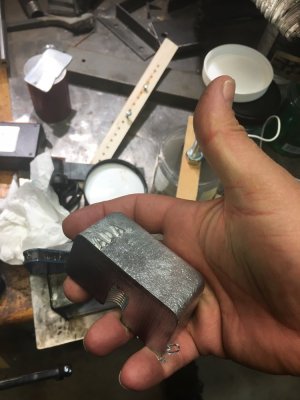I'm always interested in different rust preventing finishing techniques. Lately I've been working on zinc plating. In the photos below you can see my mad scientist setup. The top photo shows some results. I took the zinc off a 9/16 bolt (with a pickling vinegar dip) and then welded on a crude handle of hot roll scrap. Then I cleaned it up with dish detergent, rinsed in distilled water from a hand sprayer, then put it in the zinc plating bath. You can see the results look pretty good.
The zinc plating bath (acetate) is made from a mixture of vinegar, a bit of salt (1/2 tea spoon), sugar, and two zinc anodes. And a 6V DC power supply. I tried both regular salt and epsom salt - seems quite similar in results.
I found this discussion quite relevant and helpful. http://thefactoryfiveforum.com/show...-and-Bolts&s=b7498cd61f2667625dc769240f0f77d7
Here is the recipe in case the link goes down.
The plating solution recipe (which you can scale up or down as you like):
1 liter of vinegar (5%)
100 grams Epsom Salt
120 grams sugar
8 - 10 square inches of zinc pieces
Add the Epsom Salt and sugar to room temperature vinegar and stir until dissolved. Add the zinc pieces and leave lightly covered for 24 hours.
First you create a saturated zinc solution called 'zinc acetate' basically put two bars of zinc in the vinegar as a cathode and anode and turn on the 6V power for a few hours. Then remove negative anode and attach your part instead. keep turning the part as it plates to get even coverage. Takes a while for me, an hour... Then remove the part and burnish it with some steel wool. On the T-Nut you can see where the alligator clip was attached and bare steel underneath. Need to move the clip around to prevent that.
ah and the zinc - I bought a zinc anode for a crab trap off amazon.ca of all things. It's a smallish fist sized hunk and I just cut off slices. I was ordering other stuff and just added that. There are other zinc sources but this was the cheapest most convenient I could find.
Ladner Traps Zinc Anode for Crab Trap
I'm going to try a larger part next.
The zinc plating bath (acetate) is made from a mixture of vinegar, a bit of salt (1/2 tea spoon), sugar, and two zinc anodes. And a 6V DC power supply. I tried both regular salt and epsom salt - seems quite similar in results.
I found this discussion quite relevant and helpful. http://thefactoryfiveforum.com/show...-and-Bolts&s=b7498cd61f2667625dc769240f0f77d7
Here is the recipe in case the link goes down.
The plating solution recipe (which you can scale up or down as you like):
1 liter of vinegar (5%)
100 grams Epsom Salt
120 grams sugar
8 - 10 square inches of zinc pieces
Add the Epsom Salt and sugar to room temperature vinegar and stir until dissolved. Add the zinc pieces and leave lightly covered for 24 hours.
First you create a saturated zinc solution called 'zinc acetate' basically put two bars of zinc in the vinegar as a cathode and anode and turn on the 6V power for a few hours. Then remove negative anode and attach your part instead. keep turning the part as it plates to get even coverage. Takes a while for me, an hour... Then remove the part and burnish it with some steel wool. On the T-Nut you can see where the alligator clip was attached and bare steel underneath. Need to move the clip around to prevent that.
ah and the zinc - I bought a zinc anode for a crab trap off amazon.ca of all things. It's a smallish fist sized hunk and I just cut off slices. I was ordering other stuff and just added that. There are other zinc sources but this was the cheapest most convenient I could find.
Ladner Traps Zinc Anode for Crab Trap
I'm going to try a larger part next.
Attachments
Last edited:





